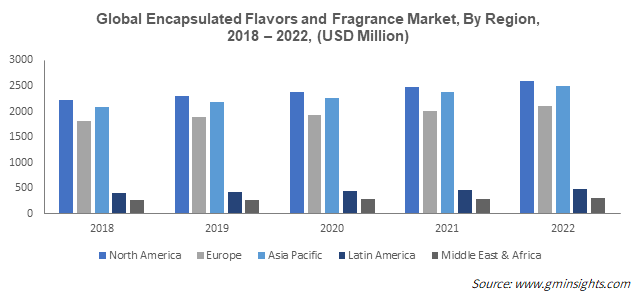Home > Food & Beverages > Food Additives > Flavor Enhancers > Encapsulated Flavors and Fragrances Market
Encapsulated Flavors and Fragrances Market Analysis
- Report ID: GMI1520
- Published Date: Feb 2023
- Report Format: PDF
Encapsulated Flavors and Fragrances Market Analysis
The encapsulated flavors and fragrances market valuation from flavor blends segment is estimated to reach USD 4.8 billion by 2032. Flavor blends are expected to witness a surge in demand from food and beverage manufacturers propelled by the increasing consumer inclination towards healthy dietary lifestyles. The rising consumption of seasonal and spicy foods has further accelerated the demand for savory flavor blends across the food industry. Moreover, the recent advancements in processing technologies have enabled the development of customized flavor blends to address the specific requirements of customers. Thus, manufacturers are rapidly integrating advanced liquid and gas chromatography equipment by integrating next-generation tools, such as predictive modeling and AI to create flavor blends with higher consumer appeal.
Encapsulated flavors and fragrances market size from the non-encapsulation process segment is anticipated to exhibit a 4.5% CAGR during the forecast timeline. The nano-encapsulation process has emerged as a promising strategy for biological packaging in several bio-availability methods. The growing emphasis on bioactive compounds for the development of functional foods will propel the production of flavors and aromas using nano-encapsulation. This technique offers numerous benefits in the field of food technology, including better food processing, pathogen detection, prolongation of shelf life, and intelligent packaging. Furthermore, the growing preference for plant-based foods is expected to proliferate the nanoencapsulation of food components to enhance bioaccessibility, targeted release, and digestion.

In terms of revenue, the physical process technology segment is set to exceed USD 10.5 billion by 2032, ascribing to its high production capacity, greater economic feasibility, feedstock versatility, and particle size flexibility. Spray dryers are extensively used to encapsulate a wide variety of flavorings suitable for use in high-temperature manufacturing environments. Some of the commonly applied physicomechanical techniques for encapsulation include extrusion, spray-drying, freeze-drying, and fluid bed coating. Food and beverage companies are increasingly deploy spray-dry flavors as they help withstand intensive production stages without compromising original sensorial properties and increase the shelf life of end-products.

Encapsulated flavors and fragrances market valuation from the food and beverage sector is expected to exceed USD 7 billion by 2032. The surging demand for flavorings and additives across the food and beverage sector can be attributed to the changing consumer dietary habits and taste preferences. Additionally, the rising penchant for diversity has encouraged manufacturers to develop customized flavors specific to consumer needs. The production and consumption of processed foods has also lately increased substantially worldwide. According to the Directorate General of Commercial Intelligence and Statistics (DGCI&S), the overall export of agricultural and processed food products increased from more than USD 11 billion in April-September 2021 to over USD 13 billion in the same period in 2022.

The North America encapsulated flavors and fragrances market size is predicted to register a 4.5% CAGR through 2032, owing to the robust presence of leading F&B manufacturers that address the burgeoning demand for ready-to-eat and ready-to-cook meals, canned soups, and snacks. The increasing consumer interest in continental cuisines and the optimum spending on luxury restaurants is proliferating the demand for authentic and exotic flavor blends in developed countries, such as the U.S. Furthermore, fast-paced lifestyles and hectic schedules have led to higher dependence on ultra-processed foods. For instance, in May 2022, Northeastern University’s Network Science Institute released data indicating that ultra-processed food accounts for more than 70% of the food supply in the U.S.

